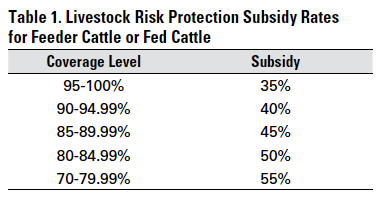Understanding Livestock Danger Protection (LRP) Insurance: A Comprehensive Overview
Navigating the world of animals threat protection (LRP) insurance can be a complicated venture for numerous in the agricultural industry. This sort of insurance coverage offers a safeguard versus market changes and unforeseen situations that might impact animals producers. By comprehending the intricacies of LRP insurance policy, manufacturers can make informed decisions that may secure their operations from economic risks. From exactly how LRP insurance coverage operates to the various coverage alternatives readily available, there is much to uncover in this extensive guide that might possibly form the method animals producers approach risk administration in their organizations.

Just How LRP Insurance Coverage Functions
Occasionally, comprehending the technicians of Livestock Danger Security (LRP) insurance can be intricate, but breaking down how it works can give clearness for breeders and farmers. LRP insurance is a danger management tool designed to protect livestock producers against unanticipated rate declines. It's vital to keep in mind that LRP insurance coverage is not a profits warranty; rather, it focuses solely on cost danger security.
Qualification and Coverage Options

When it comes to protection choices, LRP insurance policy uses producers the versatility to pick the protection level, coverage period, and recommendations that best match their danger management demands. Insurance coverage degrees normally range from 70% to 100% of the anticipated finishing value of the insured animals. Manufacturers can additionally pick protection periods that align with their manufacturing cycle, whether they are guaranteeing feeder cattle, fed cattle, swine, or lamb. Endorsements such as price threat protection can even more tailor protection to secure versus damaging market variations. By comprehending the eligibility criteria and coverage alternatives available, livestock manufacturers can make informed decisions to take care of threat effectively.
Benefits And Drawbacks of LRP Insurance
When examining Animals Risk Defense (LRP) insurance, it is essential for animals producers to evaluate the benefits and drawbacks fundamental in this danger monitoring tool.

One of the primary benefits of LRP insurance coverage is its capacity to provide security against a decline in livestock rates. In addition, LRP insurance policy provides a degree of adaptability, permitting producers to personalize insurance coverage levels and policy periods to suit their certain needs.
However, there are additionally some disadvantages to think about. One constraint of LRP insurance policy is that it does not shield against all sorts of dangers, such as illness episodes or natural calamities. Moreover, premiums can in some cases be pricey, particularly for producers with large livestock herds. It is important for click resources manufacturers to very carefully assess their individual threat exposure and economic scenario to establish if LRP insurance coverage is the appropriate danger management device for their operation.
Recognizing LRP Insurance Premiums

Tips for Maximizing LRP Advantages
Maximizing the advantages of Livestock Risk Protection (LRP) insurance policy calls for critical planning and aggressive danger monitoring - Bagley Risk Management. To maximize your LRP coverage, take into consideration the complying with ideas:
Frequently Analyze Market Problems: Stay informed about market trends and cost variations in the livestock sector. By keeping an eye on these aspects, you can make educated choices regarding when to buy LRP coverage to shield versus prospective losses.
Establish Realistic Insurance Coverage Levels: When picking insurance coverage degrees, consider your production expenses, market value of animals, and potential threats - Bagley Risk Management. Establishing practical insurance coverage levels makes sure that you are appropriately secured without overpaying for unnecessary insurance
Expand Your Protection: As opposed to relying only on LRP insurance coverage, take into consideration diversifying your danger monitoring techniques. Integrating LRP with various other risk monitoring devices such as futures agreements or choices can offer comprehensive protection versus market uncertainties.
Evaluation and Readjust Insurance Coverage Consistently: As market problems transform, regularly review your LRP coverage to guarantee it aligns with your current threat exposure. Changing coverage degrees and timing of acquisitions can aid optimize your danger security approach. By complying with these pointers, you can take full advantage of the benefits of LRP insurance coverage and secure your animals operation against unforeseen risks.
Verdict
Finally, livestock risk defense (LRP) insurance is an important tool for farmers to take care of try these out the financial threats linked with their animals procedures. By comprehending exactly how LRP functions, qualification and protection choices, as well as the pros and disadvantages of this insurance, farmers can make educated decisions to secure their incomes. By very carefully considering LRP costs and carrying out approaches to take full advantage of benefits, click here for info farmers can reduce potential losses and ensure the sustainability of their procedures.
Animals producers interested in acquiring Livestock Risk Defense (LRP) insurance policy can discover an array of eligibility requirements and insurance coverage alternatives tailored to their specific livestock procedures.When it comes to insurance coverage choices, LRP insurance coverage uses producers the flexibility to choose the protection level, insurance coverage period, and recommendations that finest match their risk administration needs.To realize the intricacies of Livestock Danger Protection (LRP) insurance completely, recognizing the factors affecting LRP insurance premiums is critical. LRP insurance coverage premiums are figured out by different elements, including the coverage degree chosen, the anticipated price of animals at the end of the protection period, the type of livestock being insured, and the length of the insurance coverage period.Testimonial and Change Coverage Regularly: As market conditions alter, occasionally review your LRP insurance coverage to ensure it straightens with your current danger direct exposure.